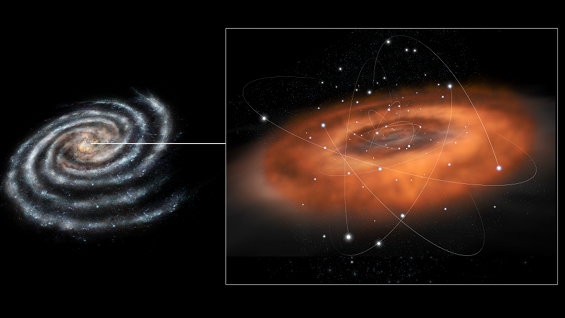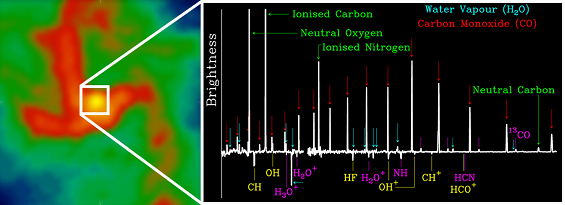Herschel reveals the Milky Way's warm heart
7 May 2013
What heats gas near supermassive black holes at the centre of galaxies? Astronomers have looked at the centre of our Galaxy, the Milky Way, with ESA's Herschel Space Observatory and discovered a rich variety of molecules at surprisingly high temperatures - up to 1000 K. The new data suggest that the molecular gas is heated up by shocks, in addition to ultraviolet radiation from massive stars close to the Galactic Centre. Shocks develop in the gas as the material surges towards Sagittarius A*, the region harbouring the supermassive black hole at the heart of the Milky Way.
 |
|
Artist's impression of the Galactic Centre. Credit: ESA - C. Carreau |
About 26 000 light-years away, the central region of the Galaxy, known as Sagittarius A*, or Sgr A*, hosts the closest supermassive black hole to Earth. With an estimated mass equivalent to about four million times that of our Sun, this black hole currently accretes matter from its surroundings at a very gentle pace, like the majority of supermassive black holes in massive galaxies across the Universe.
A few hundred times closer to Earth than the nearest galaxy hosting an actively accreting black hole, Sgr A* provides a unique chance to study the environment of supermassive black holes in great detail. However, we observe the Galactic Centre through the dense disc of the Milky Way, where gas and dust in the spiral arms of the Galaxy absorb visible light. The best way to study the interstellar material around Sgr A* is thus via infrared and radio observations.
New research based on spectroscopic data from ESA's Herschel Space Observatory has resolved the innermost portion of the Milky Way – a few light-years around Sgr A* – for the first time at far-infrared wavelengths. The team of astronomers, led by Javier Goicoechea from the Centro de Astrobiología in Madrid, Spain, was able to isolate the far-infrared emission from all the interstellar components that surround Sgr A* – neutral atomic, molecular and ionised gas, as well as dust. In particular, they exploited the characteristic signature from several molecules to trace the temperature, density and other properties of the material that orbits the central black hole and is possibly falling onto it.
"We detected a surprisingly rich variety of molecules in the environment of Sgr A* that really exceeded our expectations," comments Goicoechea. "The molecules range from highly excited carbon monoxide and water vapour, to hydrogen cyanide and many light molecules that play a critical role in the chemistry of the interstellar medium. Some of them had not been detected before Herschel," he adds.
Previous far-infrared observations, performed with ESA's Infrared Space Observatory in the 1990s, had only probed the circumnuclear disc, a dense torus of molecular gas and dust that occupies the innermost 15 light-years of the Galaxy. With Herschel's unparalleled resolution at these wavelengths, the astronomers were able to peer through the circumnuclear disc and study the 'central cavity'. With an approximate radius of only a few light-years, the cavity is filled with a less dense mixture of warm dust and gas. Part of this gas is being ionised by the strong ultraviolet radiation from massive stars that closely orbit the central black hole.
"Earlier observations performed with ground-based telescopes at near-infrared wavelengths studied the motions of these stars in great detail: with Herschel, we were able to complement these studies by examining the physical conditions and chemical composition of the interstellar medium in the same region," explains Goicoechea.
As Sgr A* slowly accretes matter, individual clouds of gas flowing from the central cavity to the black hole can sometimes be detected from radio wavelengths to X- and gamma-rays. This is consistent with the emissions from atomic and ionised gas close to Sgr A* that were also detected by Herschel, which reveal high velocity streamers of gas moving faster than 300 km/s.
"Another unexpected result from Herschel is the exceptionally high temperature of molecular gas toward the central cavity: carbon monoxide appears to reach up to 1000 K, several hundred times hotter than molecular gas in a typical interstellar cloud," says Goicoechea.
"This opened the door for us to address the problem of what heats up the gas at the centre of galaxies, as the effect of supermassive black holes on their environment is really a ‘hot topic’ in the study of galaxy evolution."
The team of astronomers examined a number of possible heating mechanisms. They excluded a dominant role from ultraviolet radiation from nearby massive stars, X-rays emitted in the vicinity of the black hole, and interactions with cosmic rays – highly energetic particles present in the interstellar medium. None of these three mechanisms seemed efficient enough to explain the high temperature of carbon monoxide gas.
"We find that shocks are are the most likely cause of the rise in temperature of the hot molecular gas in the Galactic Centre," explains Goicoechea. "The dissipation of turbulence and mechanical energy appears to be the only viable mechanism to energise the molecular gas up to 1000 K while, at the same time, preserving the molecular structure of its microscopic components."
Among the possible mechanisms producing the shocks are high-velocity clouds of gas that are surging towards the black hole, protostars being born close to the Galactic Centre and outflows blown by stellar winds.
"Herschel has observed molecular spectral lines to unravel the properties of the gas reservoir in the immediate vicinity of the supermassive black hole at the centre of our own Galaxy," comments Göran Pilbratt, Herschel Project Scientist at ESA. "This result is an important benchmark that can be very useful for the study of much more distant black-hole hosting galaxies, as well as for the numerical simulations used to investigate active galactic nuclei and their role in galaxy evolution."
Notes for editors
The study presented here is based on spectroscopic observations of Sagittarius A* (Sgr A*), the region hosting the supermassive black hole at the centre of the Galaxy. The spectra were collected with the Photodetector Array Camera and Spectrometer (PACS) and the the Spectral and Photometric Imaging Receiver (SPIRE) on board ESA's Herschel Space Observatory.
The supermassive black hole at the centre of the Galaxy has an estimated mass of about four millions of solar masses. Like the majority of black holes hosted at the centre of massive galaxies across the Universe, it currently accretes matter from its surroundings at very moderate rates compared to the more intense accretion processes that characterise black holes in Active Galactic Nuclei (AGN).
The work presented here studies the reservoir of material accreting onto Sgr A* at scales of a few light-years. Higher resolution observations, performed at near-infrared wavelengths, have shown that a cloud of gas, known as G2, is currently approaching very close to the black hole. This is related to the recent detection of a flare from Sgr A*, observed in X-rays with NASA's Swift satellite as part of a monitoring campaign to study the interaction of Sgr A* with the G2 cloud, which will have its closest encounter with the black hole in late 2013.
Spectra from PACS were obtained in March 2011 and March 2012 and cover the wavelength range between 52 and 190 microns. Spectra from SPIRE were obtained in February 2011 and cover the wavelength range between 194 and 671 microns. These observations were performed as part of the two Herschel Guaranteed Time Key Programmes "PRISMAS: PRobing InterStellar Molecules with Absorption line Studies" (Principal Investigator: Maryvonne Gerin, Observatoire de Paris and École Normale Supérieure, France) and "SPECHIS: SPIRE Spectral Line Surveys of HIFI-GT-KP Sources" (Principal Investigator: Edward Polehampton, Rutherford Appleton Laboratory, UK, and Institute for Space Imaging Science, University of Lethbridge, Canada).
Herschel is an ESA space observatory with science instruments provided by European-led Principal Investigator consortia and with important participation from NASA.
The PACS instrument contains an imaging photometer (camera) and an imaging spectrometer. The camera operates in three bands centred on 70, 100, and 160 μm, respectively, and the spectrometer covers the wavelength range between 51 and 220 μm. PACS has been developed by a consortium of institutes led by MPE (Germany) and including UVIE (Austria); KU Leuven, CSL, IMEC (Belgium); CEA, LAM (France); MPIA (Germany); INAF-IFSI/OAA/OAP/OAT, LENS, SISSA (Italy); IAC (Spain). This development has been supported by the funding agencies BMVIT (Austria), ESA-PRODEX (Belgium), CEA/CNES (France), DLR (Germany), ASI/INAF (Italy), and CICYT/MCYT (Spain).
The SPIRE instrument contains an imaging photometer (camera) and an imaging spectrometer. The camera operates in three wavelength bands centred on 250, 350 and 500 µm, and so can make images of the sky simultaneously in three sub-millimetre colours; the spectrometer covers the wavelength range between 194 and 671 μm. SPIRE has been developed by a consortium of institutes led by Cardiff Univ. (UK) and including Univ. Lethbridge (Canada); NAOC (China); CEA, LAM (France); IFSI, Univ. Padua (Italy); IAC (Spain); Stockholm Observatory (Sweden); Imperial College London, RAL, UCL-MSSL, UKATC, Univ. Sussex (UK); Caltech, JPL, NHSC, Univ. Colorado (USA). This development has been supported by national funding agencies: CSA (Canada); NAOC (China); CEA, CNES, CNRS (France); ASI (Italy); MCINN (Spain); SNSB (Sweden); STFC (UK); and NASA (USA).
Herschel was launched on 14 May 2009 and completed science observations on 29 April 2013.
Related publications
J. R. Goicoechea, et al., "Herschel Far-Infrared Spectroscopy of the Galactic Center. Hot Molecular Gas: Shocks versus Radiation near Sgr A*", 2013, Astrophysical Journal Letters, in press
Contacts
Javier R. Goicoechea
Centro de Astrobiología (CSIC-INTA)
Madrid, Spain
Email: jr.goicoechea![]() cab.inta-csic.es
cab.inta-csic.es
Phone: +34-91-520-6422
Göran Pilbratt
Herschel Project Scientist
Research and Scientific Support Department
Science and Robotic Exploration Directorate
ESA, The Netherlands
Email: gpilbratt![]() rssd.esa.int
rssd.esa.int
Phone: +31-71-565-3621



